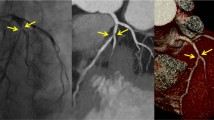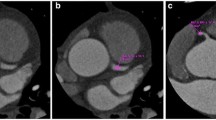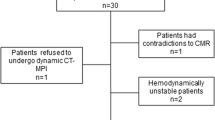Abstract
To assess image quality and radiation exposure with prospectively gated axial CT coronary angiography (PGA) compared to retrospectively gated helical techniques (RGH). Forty patients with suspected coronary artery disease (CAD) and a stable heart rate below 65 bpm underwent CT coronary angiography (CTCA) using a 64-channel CT system. The patient cohort consisted of 20 consecutive patients examined using a PGA technique and 20 patients examined using a standard RGH technique. Both groups were matched demographically according to age, gender, body mass index, and heart rate. For both groups, two independent observers assessed image quality for all coronary segments on an ordinal scale from 1 (nonassessable) to 5 (excellent quality). Image quality and radiation exposure were compared between patient groups. There were no significant differences in vessel-based image quality between the two groups (P > 0.05). Mean (± SD) effective radiation exposure in the PGA group was 3.7 ± 0.8 mSv compared to 18.9 ± 3.8 mSv in the RGH group without ECG-based tube current modulation (P < 0.001). Preliminary experience shows PGA technique to be a promising approach for CTCA resulting in a substantial reduction in radiation exposure with image quality comparable to that of standard RGH technique.




Similar content being viewed by others
References
Leschka S et al (2006) Noninvasive coronary angiography with 64-section CT: effect of average heart rate and heart rate variability on image quality. Radiology 241(2):378–385
Dewey M, Hoffmann H, Hamm B (2006) Multislice CT coronary angiography: effect of sublingual nitroglycerine on the diameter of coronary arteries. RöfFo 178(6):600–604
Hoffmann MH et al (2005) Noninvasive coronary angiography with multislice computed tomography. JAMA 293(20):2471–2478
Katritsis D et al (2000) Radiation exposure of patients and coronary arteries in the stent era: a prospective study. Catheter Cardiovasc Interv 51(3):259–264
Watson LE, Riggs MW, Bourland PD (1997) Radiation exposure during cardiology fellowship training. Health Phys 73(4):690–693
Miller SW, Castronovo FP Jr (1985) Radiation exposure and protection in cardiac catheterization laboratories. Am J Cardiol 55(1):171–176
Kocinaj D et al (2006) Radiation dose exposure during cardiac and peripheral arteries catheterisation. Int J Cardiol 113(2):283–284
Dewey M et al (2006) Noninvasive detection of coronary artery stenoses with multislice computed tomography or magnetic resonance imaging. Ann Intern Med 145(6):407–415
Hoffmann U et al (2006) Cardiac CT in emergency department patients with acute chest pain. Radiographics 26(4):963–978, discussion 979–80
Trabold T et al (2003) Estimation of radiation exposure in 16-detector row computed tomography of the heart with retrospective ECG-gating. RöFo 175(8):1051–1055
Mori S et al (2008) Effective doses in subjects undergoing computed tomography cardiac imaging with the 256-multislice CT scanner. Eur J Radiol 65(3):442–448
Poll LW et al (2002) Dose reduction in multi-slice CT of the heart by use of ECG-controlled tube current modulation (“ECG pulsing”): phantom measurements. RöFo 174(12):1500–1505
Einstein AJ, Henzlova MJ, Rajagopalan S (2007) Estimating risk of cancer associated with radiation exposure from 64-slice computed tomography coronary angiography. JAMA 298(3):317–323
Einstein AJ et al (2007) Radiation dose to patients from cardiac diagnostic imaging. Circulation 116(11):1290–1305
Thomas CK et al (2006) Coronary artery calcium scoring with multislice computed tomography: in vitro assessment of a low tube voltage protocol. Invest Radiol 41(9):668–673
Hsieh J et al (2006) Step-and-shoot data acquisition and reconstruction for cardiac x-ray computed tomography. Med Phys 33(11):4236–4248
Husmann L et al (2008) Feasibility of low-dose coronary CT angiography: first experience with prospective ECG-gating. Eur Heart J 29(2):191–197
Schoenhagen P (2008) Back to the future: coronary CT angiography using prospective ECG triggering. Eur Heart J 29(2):153–154
Earls JP et al (2008) Prospectively gated transverse coronary CT angiography versus retrospectively gated helical technique: improved image quality and reduced radiation dose. Radiology 246(3):742–753
Shuman WP et al (2008) Prospective versus retrospective ECG gating for 64-detector CT of the coronary arteries: comparison of image quality and patient radiation dose. Radiology 248(2):431–437
Vembar M et al (2003) A dynamic approach to identifying desired physiological phases for cardiac imaging using multislice spiral CT. Med Phys 30(7):1683–1693
Austen WG et al (1975) A reporting system on patients evaluated for coronary artery disease. Report of the Ad Hoc Committee for Grading of Coronary Artery Disease, Council on Cardiovascular Surgery, American Heart Association. Circulation 51(4 Suppl):5–40
Heuscher DJ, Chandra S (2003) Multi-phase cardiac imager. US patent no. 6,510,337. http://patft.uspto.gov/netacgi/nph-Parser?Sect1=PTO1&Sect2=HITOFF&d=PALL&p=1&u=%2Fnetahtml%2FPTO%2Fsrchnum.htm&r=1&f=G&l=50&s1=6510337.PN.&OS=PN/6510337&RS=PN/6510337. Accessed 28 July 2008
Manzke R et al (2003) Adaptive temporal resolution optimization in helical cardiac cone beam CT reconstruction. Med Phys 30(12):3072–3080
Shrout PE, Fleiss JL (1979) Intraclass correlations: uses in assessing rater reliability. Psychol Bull 86(2):420–428
European Commission (1999) European guidelines on quality criteria for computed tomography. Report EUR 16262 EN. Office for Official Publication of the European Communities, Luxembourg. http://www.drs.dk/guidelines/ct/quality/index.htm. Accessed 28 July 2008
Karaca M et al (2007) Contrast-enhanced 64-slice computed tomography in detection and evaluation of anomalous coronary arteries Tohoku. J Exp Med 213(3):249–259
Marano R et al (2007) Coronary artery bypass grafts and MDCT imaging: what to know and what to look for. Eur Radiol 17(12):3166–3178
Zhang ZH et al (2006) Comparison of coronary artery bypass graft imaging between 64-slice and 16-slice spiral CT (in Chinese). Zhongguo Yi Xue Ke Xue Yuan Xue Bao 28(1):21–25
Huda W, Vance A (2007) Patient radiation doses from adult and pediatric CT. AJR Am J Roentgenol 188(2):540–546
Paul JF, Abada HT (2007) Strategies for reduction of radiation dose in cardiac multislice CT. Eur Radiol 17(8):2028–2037
Jakobs TF et al (2002) Multislice helical CT of the heart with retrospective ECG gating: reduction of radiation exposure by ECG-controlled tube current modulation. Eur Radiol 12(5):1081–1086
Johnson TR et al (2006) Dual-source CT cardiac imaging: initial experience. Eur Radiol 16(7):1409–1415
Stolzmann P et al (2008) Radiation dose estimates in dual-source computed tomography coronary angiography. Eur Radiol 18(3):592–599
Jung B et al (2003) Individually weight-adapted examination protocol in retrospectively ECG-gated MSCT of the heart. Eur Radiol 13(12):2560–2566
Abada HT et al (2006) MDCT of the coronary arteries: feasibility of low-dose CT with ECG-pulsed tube current modulation to reduce radiation dose. AJR Am J Roentgenol 186(6 Suppl 2):S387–S390
Jakobs TF et al (2002) Multislice helical CT of the heart with retrospective ECG gating: reduction of radiation exposure by ECG-controlled tube current modulation. Eur Radiol 12(5):1081–1086
Acknowledgements
This study has been exclusively financed from research funds provided by the state of Baden-Württemberg, Germany.
Author information
Authors and Affiliations
Corresponding author
Additional information
This paper has not yet been submitted for publication elsewhere.
The abstract was accepted for presentation in the scientific sessions of ESR 2008.
Rights and permissions
About this article
Cite this article
Klass, O., Jeltsch, M., Feuerlein, S. et al. Prospectively gated axial CT coronary angiography: preliminary experiences with a novel low-dose technique. Eur Radiol 19, 829–836 (2009). https://doi.org/10.1007/s00330-008-1222-4
Received:
Revised:
Accepted:
Published:
Issue Date:
DOI: https://doi.org/10.1007/s00330-008-1222-4




